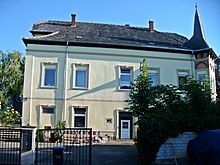Lambsheim hunting lodge
The former hunting lodge Lambsheim is located at Am Schlossgarten 14 in Lambsheim .
history
The castle grounds are located northwest of the Isenach and were irrigated from there by means of an artificial ditch, which is why knight Sebastian I von Meckenheim already owned a garden area here in 1550, which was named Weihergarten . At that time, the site was in the open-air area, south of Lambsheim, near the (still existing) mill. In the meantime the village has grown around it and beyond.
The aforementioned Weihergarten acquired the Palatinate General Johann Wilhelm von Efferen († 1724) at the beginning of the 18th century and had the hunting lodge built there in 1706 as a country residence. At the same time he had also bought the Meckenheimer Schloss in the center of the village (Junkergasse).
After his death, both castles were sold to Baron Ludwig Anton von Hacke in 1725 . He was Oberstforst- and Oberstjägermeister from the Electoral Palatinate , as well as the owner of the independent Trippstadt rule , but mostly stayed in Mannheim . As a forest connoisseur and lover, he had the park extended at the hunting lodge and equipped with rare trees and plants; a gardener was employed permanently. For Baron von Hacke, the Lambsheimer Jagdschloss represented a recreational idyll near the royal seat of Mannheim, to which he repeatedly withdrew. Even Elector Karl Theodor came here to visit, as his wife Elisabeth Auguste von Pfalz-Sulzbach noted in a letter dated April 30, 1743 to her brother-in-law Clemens Franz de Paula of Bavaria : “Yesterday we went to Lambsheim at Hack, where the most beautiful garden in the world. "
During the French period , the von Hacke family was expropriated and the Lambsheim miller Georg Reudelhuber bought the property. Through him it came to his son-in-law, the doctor and later member of the Reichstag, Ludwig Philipp Groß († 1894), who rebuilt and expanded the property in 1890. The hunting lodge has remained in private ownership to this day and is of historical importance as a baroque aristocratic seat outside the historic fortifications .
Building stock
The two-storey plastered building with a large flight of stairs was designed as a moated castle and surrounded by a garden. In 1890 a renovation was carried out in the style of historicism , whereby the basic baroque structure, especially on the ground floor, was largely retained.
From 1968 the garden was largely built on and the moats filled in. The administration building (Mühltorstraße 25), also built in 1706 and donated to the community in 1936 , belonged to the hunting lodge . The two-and-a-half-story angular building was initially used as a farm, then as a residential building. Since its renovation in 1991, it has served as the town hall.
literature
- Heinrich Rembe: Lambsheim , Volume 2, pp. 59, 60 and 77, Arbogast-Verlag, Otterbach, 1983
- Hans-Helmut Görtz: The builder of the Lambsheimer Jagdschloss , in: Heimat-Jahrbuch des Rheinpfalz-Kreis, Volume 30, (2014), pp. 110-118, ISBN 978-3-00-042960-6
Web links
- Entry on Jagdschloss Lambsheim in the private database "Alle Burgen".
Individual evidence
- ^ Erich Graf von Kielmansegg: Letters from Duke Ernst August zu Braunschweig-Lüedburg to Johann Franz Diedrich von Wendt from the years 1703 to 1726 , 1902, p. 229; (Digital scan of General von Efferen)
Coordinates: 49 ° 30 ′ 30 ″ N , 8 ° 17 ′ 9 ″ E


